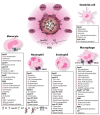Current Understanding of the Immunomodulatory Activities of High-Density Lipoproteins
- PMID: 34064071
- PMCID: PMC8224331
- DOI: 10.3390/biomedicines9060587
Current Understanding of the Immunomodulatory Activities of High-Density Lipoproteins
Abstract
Lipoproteins interact with immune cells, macrophages and endothelial cells - key players of the innate and adaptive immune system. High-density lipoprotein (HDL) particles seem to have evolved as part of the innate immune system since certain HDL subspecies contain combinations of apolipoproteins with immune regulatory functions. HDL is enriched in anti-inflammatory lipids, such as sphingosine-1-phosphate and certain saturated lysophospholipids. HDL reduces inflammation and protects against infection by modulating immune cell function, vasodilation and endothelial barrier function. HDL suppresses immune cell activation at least in part by modulating the cholesterol content in cholesterol/sphingolipid-rich membrane domains (lipid rafts), which play a critical role in the compartmentalization of signaling pathways. Acute infections, inflammation or autoimmune diseases lower HDL cholesterol levels and significantly alter HDL metabolism, composition and function. Such alterations could have a major impact on disease progression and may affect the risk for infections and cardiovascular disease. This review article aims to provide a comprehensive overview of the immune cell modulatory activities of HDL. We focus on newly discovered activities of HDL-associated apolipoproteins, enzymes, lipids, and HDL mimetic peptides.
Keywords: HDL function; T cells; dendritic cells; eosinophils; high-density lipoprotein; immunomodulation; macrophages; monocytes; neutrophils.
Conflict of interest statement
The authors declare no conflict of interest.
Figures

Similar articles
-
Emerging role of high density lipoproteins as a player in the immune system.Atherosclerosis. 2012 Jan;220(1):11-21. doi: 10.1016/j.atherosclerosis.2011.06.045. Epub 2011 Jul 2. Atherosclerosis. 2012. PMID: 21783193 Review.
-
High-Density Lipoprotein-Associated Apolipoprotein M Limits Endothelial Inflammation by Delivering Sphingosine-1-Phosphate to the Sphingosine-1-Phosphate Receptor 1.Arterioscler Thromb Vasc Biol. 2017 Jan;37(1):118-129. doi: 10.1161/ATVBAHA.116.308435. Epub 2016 Nov 22. Arterioscler Thromb Vasc Biol. 2017. PMID: 27879252
-
High-Density Lipoprotein (HDL) in Allergy and Skin Diseases: Focus on Immunomodulating Functions.Biomedicines. 2020 Dec 1;8(12):558. doi: 10.3390/biomedicines8120558. Biomedicines. 2020. PMID: 33271807 Free PMC article. Review.
-
High-density lipoproteins and immune response: A review.Int J Biol Macromol. 2022 Jan 15;195:117-123. doi: 10.1016/j.ijbiomac.2021.12.009. Epub 2021 Dec 9. Int J Biol Macromol. 2022. PMID: 34896462 Review.
-
[The role of apolipoprotein M and sphingosine 1-phosphate axis in the prevention of atherosclerosis].Orv Hetil. 2018 Feb;159(5):168-175. doi: 10.1556/650.2018.30980. Orv Hetil. 2018. PMID: 29376427 Review. Hungarian.
Cited by
-
The emerging roles of sphingosine 1-phosphate and SphK1 in cancer resistance: a promising therapeutic target.Cancer Cell Int. 2024 Feb 28;24(1):89. doi: 10.1186/s12935-024-03221-8. Cancer Cell Int. 2024. PMID: 38419070 Free PMC article. Review.
-
HDL Function and Atherosclerosis: Reactive Dicarbonyls as Promising Targets of Therapy.Circ Res. 2023 May 26;132(11):1521-1545. doi: 10.1161/CIRCRESAHA.123.321563. Epub 2023 May 25. Circ Res. 2023. PMID: 37228232 Free PMC article. Review.
-
CIGB-258 Exerts Potent Anti-Inflammatory Activity against Carboxymethyllysine-Induced Acute Inflammation in Hyperlipidemic Zebrafish via the Protection of Apolipoprotein A-I.Int J Mol Sci. 2023 Apr 11;24(8):7044. doi: 10.3390/ijms24087044. Int J Mol Sci. 2023. PMID: 37108210 Free PMC article.
-
Dietary Strategies to Improve Cardiovascular Health: Focus on Increasing High-Density Lipoprotein Functionality.Front Nutr. 2021 Nov 22;8:761170. doi: 10.3389/fnut.2021.761170. eCollection 2021. Front Nutr. 2021. PMID: 34881279 Free PMC article. Review.
-
A Nomogram That Includes Neutrophils and High-Density Lipoprotein Cholesterol Can Predict the Prognosis of Acute Ischaemic Stroke.Front Neurol. 2022 Feb 25;13:827279. doi: 10.3389/fneur.2022.827279. eCollection 2022. Front Neurol. 2022. PMID: 35280284 Free PMC article.
References
Publication types
Grants and funding
LinkOut - more resources
Full Text Sources

